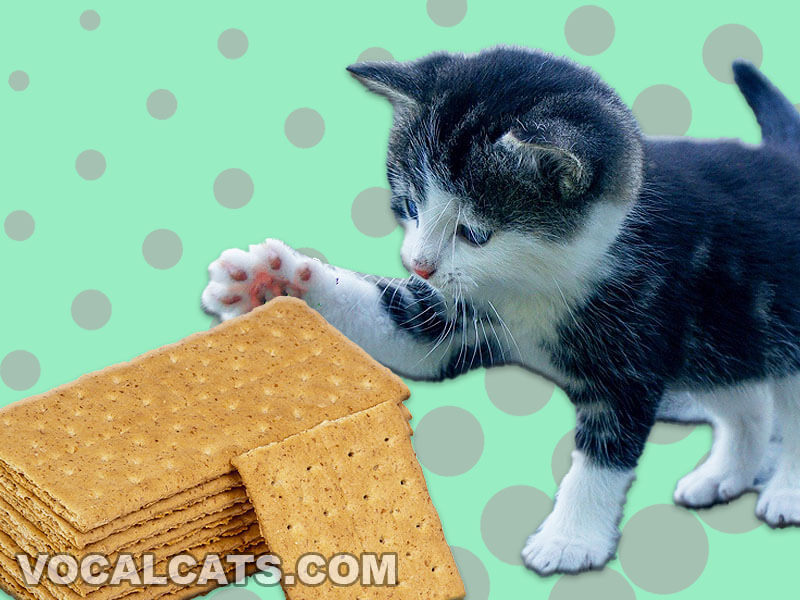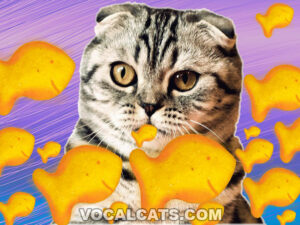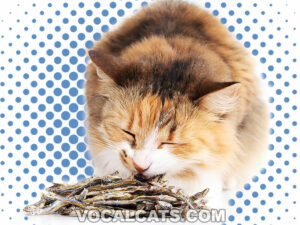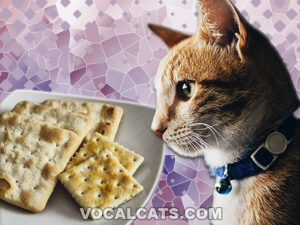Can cats eat Graham Crackers? No, cats should not eat Graham Crackers because this crunchy human snack is high in calories, sodium, carbohydrates, sugar, and fats. Most of the ingredients in Graham Crackers are neither safe nor healthy for feline-consumption. Cats that consume Graham Crackers regularly may have health issues such as diabetes, weight gain, digestive issues, and even sodium poisoning.
We know that cats are carnivores and thrive on animal meat and protein rather than snacks made for people. A cat’s digestive system is sensitive when it comes to eating baked goods that contain flour. That’s because cats only have a small amount of amylase, a carbohydrate-digesting enzyme that’s found in their saliva, pancreas, and intestines compared with other animals.
To prevent your feline friends from developing long-term health issues, you should provide them with a balanced diet that contains around 50% protein and 30 to 40% fat.
Contents
- Can cats have Graham Crackers?
- What are Graham Crackers?
- Are Graham Crackers bad for cats?
- Do Graham Crackers provide any nutritional benefits for your cat?
- What if my cat accidentally ate Graham Crackers? What will happen? What should I do?
- Treatments if your cat has food poisoning from Graham Crackers
- Cats and Graham Crackers: Different types
- Can cats eat Honey Graham Crackers?
- Can cats eat Honey Maid Graham Crackers?
- Can cats eat cinnamon Graham Crackers?
- What are some feline-friendly and safe non-toxic Graham Crackers alternatives?
- So, can cats eat Graham Crackers?
- Related Questions
Can cats have Graham Crackers?
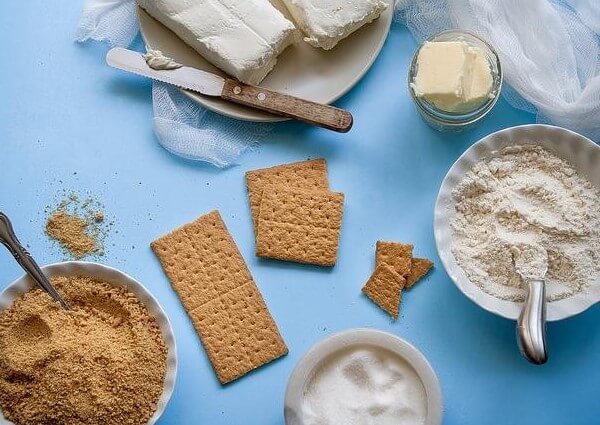
No, cats should not have Graham Crackers. They can take a nibble or two from your Graham Cracker, but it’s not recommended that they keep munching on one regularly.
Due to high amounts of salt, sugar, and flour in Graham Crackers, regular consumption can lead to feline obesity, diabetes, and various digestive problems, such as vomiting, diarrhea, and lethargy.
What are Graham Crackers?
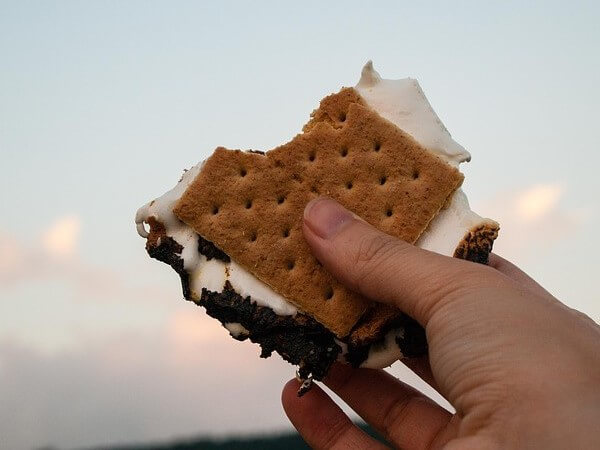
If you have ever enjoyed a s’mores, you probably already know what a Graham Cracker is and what it looks like. Graham Crackers are square-shaped or rectangular-shaped cookies that have ridges on both sides. They are made from graham flour, unbleached enriched flour, sugar, salt, molasses, and leavening such as baking soda and soybean oil.
Graham Crackers are available in different flavors, such as honey, chocolate, and cinnamon, to add variety to the taste. However, they were not always the way they are now. Graham Crackers have evolved through the years since Reverend Sylvester Graham first invented them in the 1830s in New Jersey.
The concept of Graham Crackers came about after Sylvester Graham saw many people consuming white flour. As a vegetarian, he believed that overprocessing wheat flour stripped the flour from its fiber and other nutrients leading to a decline in the consumer’s health.
When Graham Crackers were introduced initially, they were made from graham flour; a type of wheat you get when you grind the winter wheat’s endosperm to a fine powder and then mix it with the bran and grain. Graham flour is coarse to the touch, contains gluten, and has a nutty flavor.
Are Graham Crackers bad for cats?
Yes, Graham Crackers are bad for cats. A cat should have a diet that has less than 10% carbohydrates, while the rest of the diet should include animal-based protein and fat.
However, just two Graham Crackers contain about 6 grams of carbohydrates. When consumed too often, your cat won’t be able to digest the accumulating carbs, leading to digestion issues, diarrhea, and even diabetes. Additionally, regularly allowing your feline friends to consume Graham Crackers would lead to unhealthy weight gain that can escalate to feline obesity.
Graham Crackers also contain a lot of sodium. In just two Graham Crackers, there are 42.6 mg of sodium.
To know whether there are any other ingredients in Graham Crackers that can harm our fuzzy friend’s health, we’ll take a look at the ingredients in Graham Crackers and discuss how each one of them affects your four-legged friends.
Ingredients in Graham Crackers
- Unbleached enriched flour which includes wheat flour, niacin, reduced iron, thiamine mononitrate (vitamin B1), riboflavin (vitamin B2), and folic acid.
- Graham flour which includes whole grain wheat flour.
- Sugar.
- Canola oil.
- Molasses.
- Palm oil.
- Leavening which includes baking soda and/or calcium phosphate.
- Salt.
Unbleached enriched flour is harmful to cats with wheat allergy
The word, “unbleached” refers to flour that isn’t chemically treated so it ages naturally and has an off-white color compared to bleached flour. However, unbleached flour still has to go through a lot of processing during the milling process, and highly refined flour isn’t great for cats.
During the making of unbleached enriched flour, the bran and the germ are removed from the wheat kernel, leaving behind only the endosperm. However, it is the bran and the germ that contains a large number of nutrients. The resulting flour is more refined yet lacks its nutritional value.
Later on, the flour is “enriched” with nutrients that were lost when the bran and the germ were stripped away from the wheat kernel. These nutrients that were added back into the unbleached enriched flour includes folic acid, thiamine mononitrate (vitamin B1), reduced iron, riboflavin (vitamin B2), and niacin. However, it doesn’t affect the overall amount of carbohydrates in the flour.
One serving of unbleached enriched flour has 22 grams of total carbs, 4 grams of protein, and 110 calories. A cat’s diet should contain the following:
- 50% animal-based protein.
- 30 to 40% fat.
- Less than 10% carbohydrate.
Also, unbleached enriched flour only raises your cat’s blood sugar level for a while and stores most of the calories as fat, which can lead to weight gain and over the long run, feline-obesity.
We also wanted to point out that Graham Crackers are mainly made out of unbleached enriched flour. We know this because it is the first item listed in the ingredient list.
If your feline family member is allergic or sensitive to wheat, please do not offer any Graham Crackers to him or her. In some cases, what allergy may be developed over time due to constant exposure to wheat products.
If you’re not sure whether your furry friend has wheat or gluten allergies, we highly recommend that you contact your vet to find out.
At any rate, here is a list of symptoms if your cat has wheat allergy:
- Itchy skin.
- Hair loss.
- Skin lesions.
- Excessive drooling.
- Crusty papules.
- Acute moist dermatitis.
Graham flour is safe for cats that do not have wheat or gluten allergy
This course-ground flour was what was initially used to make Graham Crackers. It is unrefined, unsifted flour that is courser than its refiner versions. 100 g of Graham flour has around 72 grams of total carbohydrates, which is too much for cats.
As we can see from the ingredient list, graham flour is made of whole grain wheat flour. Thus, if your cat has wheat or gluten allergy, it’s best not to give her Graham Crackers.
Also keep in mind that our little furball do not require wheat or grain in her daily diet. In fact, many vets recommend that you feed your kitties a daily diet that contains 70% or more meat-based protein since cats are obligate carnivores.
Too much sugar can lead to weight gain and diabetes in cats
Although cats can’t taste sugar, too much sugar in their diet can overwhelm them. Our feline family member lack the glucokinase enzyme in their liver which prevents sweets from digesting properly. For this reason, cats should not have more than 3% sugar in their daily meals.
If your fuzzy friend consume sugar regularly from different food sources including Graham Crackers, he may start to experience the following symptoms:
- Vomiting.
- Diarrhea.
- Abdominal discomfort.
- Diabetes mellitus (sugar diabetes or Type II diabetes).
- Weight gain; regular sugar consumption can lead to feline obesity.
- Dental issues: tooth decay, loss of enamel, and tooth loss.
Molasses is also sugar and is unhealthy for cats
As we discuss above, sugar in any form is unhealthy and will have a negative effect on your fuzzy friend’s health, both in the short term and over the long term.
Molasses is another ingredient that is used to make Graham Crackers. Molasses is a form of sugar that usually comes from either sugar beets or sugar cane. It is a dark, thick syrup made from boiling either the sugar beet juice or the sugar cane. The color of the molasses varies depending on how long it has been cooked and whether you used sugar cane or sugar beets.
For instance, if you use sugar cane juice, you can expect dark molasses with a rich and strong flavor. On the contrary, if you use sugar beet juice, you can expect a lighter-colored molasses with a mild flavor.
Because it is a type of sugar and it has a high sugar content, our furry friends’ body will have a hard time digesting molasses or sugar, especially since they lack the glucokinase enzyme in their liver that helps to properly digest sugar. This can lead to an upset stomach in cats.
In fact, many veterinarians advise cat owners not to give their feline family members any food products that contain molasses in them.
This is why it’s safe to say that our kitties should not eat Graham Crackers.
Canola oil and Palm oil are both harmful to cats
Palm oil is high in saturated fat and it is often the type of oil that is used in packaged products like Graham Crackers. That’s because palm oil is a cheap vegetable oil and can cause the following health issues in cats:
- Diarrhea.
- Vomiting.
- Dehydration.
- Gastrointestinal tract blockage (in severe cases with high consumption).
- Lethargy.
- Kidney failure (in severe cases and with high consumption).
- Liver damage (in severe cases and with high consumption).
- Pancreatitis (in severe cases).
When it comes to canola oil, many veterinarians advised against feeding your cat any food or snack that contains canola oil in it. It is possible that the canola oil can form a latex like substance in your feline friend’s blood and cause health issues such as:
- Anemia.
- Blindness.
- Respiratory and breathing difficulties.
- Constipation.
- Nervous system damage.
For these reasons, it’s best not to feed your little furballs Graham Crackers.
Instead of canola oil or palm oil, there are plenty of healthy oil for our feline companions. These include:
- Coconut oil. It is a good idea to give your feline friends some coconut oil, especially if they are experiencing digestion issues, inflammatory bowel disease, lethargy, or weight issues. That’s because coconut oil contains high MCT (medium-chain triglycerides) content which can improve your cat’s brain health, increase energy levels, and assist your feline friends in absorbing the nutrients from their food more efficiently.
- Olive oil. If your cat has diabetes, weight issues, or cardiovascular disease, providing them food with olive oil is a great option. Olive oil contains carotenoids, vitamin E, chlorophyll, and polyphenols. In its purest form, olive oil is a great choice for cats that can’t tolerate omega-3 or omega-6 fatty acids.
- Fish oil. If your cat has inflammation due to hot spots, allergies, or itchiness, try giving your kitty cats a drop or two of fish oil. Containing essential fatty acids like EPA and DHA, as well as omega-3 fatty acids, the fish oil can help improve your cat’s skin and coat.
- Cod Liver oil. Although cod liver oil doesn’t have as much omega-3 and omega-6 fatty acids as other fish oils, your furry friends can still benefit from the vitamin D and A.
- Hemp oil. If your cat is feeling sick or has joint pain, muscle pain, or anxiety, try giving him a drop of hemp oil. Hemp oil contains minerals, vitamins, antioxidants, and omega-3 and omega-6 fatty acids which can help calm your cat’s nerves, fight infections, promote healthy immune system and metabolism, and best of all, keep your feline’s coat and skin healthy and moisturized.
- Sunflower oil. Many cat food and cat treats contain sunflower oil. If you’re looking to boost your feline friend’s immune system, promote healthy heart and normal organ function, sunflower oil is a great choice. It can also help to moisturize your kitten’s skin and coat.
Leavening is not necessary in a cat’s diet
We can see from the ingredient list that leavening contains baking soda and/or calcium phosphate. If your feline companion ingest a large amount of baking soda, the amount of potassium and calcium in his body decreases while sodium increases. This electrolyte imbalance can cause diarrhea, shortness of breath, dehydration, vomiting, and even disorientation in cats.
A little bit of baking soda is fine if you’re making him homemade cat food or treats, but if it exceeds one teaspoon per pound of their body weight, it can be dangerous for their health.
High salt level in Graham Crackers can lead to sodium poisoning in cats
While our little furballs require sodium in their daily diet for proper muscle and nerve functions, too much salt intake can actually be bad for cats.
Salt can become a toxin if your feline family member consume from than 41 mg of salt per day. If your kitties are showing signs and symptoms of sodium poisoning or hypernatremia such as lethargy, vomiting, diarrhea, tremors, or incoordination, we highly recommend that you contact your vet as soon as possible.
Your vet may ask you to bring your kitties in for a physical and health checkup and help lower the salt levels in their bodies. In some cases, your furry friends may have to stay in the hospital overnight as it takes hours (or even days) to slowly lower the salt levels in their bodies.
Keep in mind that our kittens should only receive their salt intake from their regular cat food.
RECOMMENDED: Can Cats Eat Goldfish Crackers?
Do Graham Crackers provide any nutritional benefits for your cat?
No, Graham Crackers do not provide any nutritional benefits to your cats. If we take a look at one of the popular Graham Cracker brand on the market, we find this:
Nutritional value of Graham Crackers
Nabisco Original Graham Crackers Nutritional profile (1 Cracker or 3.9 grams)
| Name, Unit | Amount |
| Calories, cal | 16.3 |
| Total Fat, g | 0.4 |
| Saturated Fat, g | 0.1 |
| Sodium, mg | 21.3 |
| Total Carbohydrate, g | 3 |
| Dietary Fiber, g | 0.1 |
| Total Sugars, g | 1 |
| Protein, g | 0.3 |
| Calcium, mg | 2.5 |
| Potassium, mg | 7.5 |
| Iron, mg | 0.14 |
As we can see, just one Nabisco original Graham Cracker contains about 16 calories, 0.4 grams of fat (0.1 grams saturated), 3 grams of carbohydrate (1 gram of sugar), and 21.3 grams of sodium.
From this nutritional profile, we see that Graham Crackers contain 71% carbs, 23% fat, and just 6% protein. There is simply not enough of the right protein, fat, or fiber for our feline friends.
Instead, Graham Crackers are full of carbs which cats can’t digest properly and a high salt level that can lead to salt poisoning in cats.
The flour used in Graham Crackers is mainly unbleached enriched floor that is highly refined and nothing like the whole wheat flour used in the 1830s when Graham Crackers were first made. Cats should already receive any of their carb intake from their regular cat food and snacking on Graham Crackers would only exceed their carb intake.
For these reasons, Graham Crackers are not healthy for our four-legged friends.
What if my cat accidentally ate Graham Crackers? What will happen? What should I do?
If your cat accidentally ate Graham Crackers, don’t fret! Before you start to panic, you’ll be glad to know that your little fur baby will be fine if she had one or two nibbles of the Graham Crackers. We do recommend that you monitor your feline friends closely for any changes in behaviors or symptoms for at least 12-24 hours after she consumed the Graham Crackers.
However, if you notice that your entire pack of Graham Crackers is gone, you should call your vet as soon as possible and bring your cat to see the vet or an emergency clinic.
Once at the veterinary hospital, your vet will perform a series of test including a physical checkup. Your vet may also induce vomiting to prevent any long-term health issue. Please do not do this yourself and allow a veterinary professional to handle this.
During this whole process, it’s best to stay calm and assess the situation logically. Avoid getting upset and making wrong, hasty decisions. The most critical thing to remember is that your cat needs you, so you must stay present and calm.
Symptoms to Watch For
If you left your box of Graham Crackers lying around or near your little fur babies and you believe they have taken advantage of that, you’ll want to observe their behavior and check for any abnormal symptoms for at least 24 hours.
Should you find the following signs and symptoms after your feline family member has consumed some Graham Crackers, we highly advised that you contact your vet immediately or rush them to a veterinary hospital before something serious happens.
Here are some common signs and symptoms in cats after they have over-indulged in Graham Crackers:
- Diarrhea.
- Vomiting.
- Lethargy.
- Tremors.
- Disorientation.
- Incoordination.
- Loss of appetite.
- Seizures (in severe cases).
Treatments if your cat has food poisoning from Graham Crackers
Almost all the ingredients in Graham Crackers aren’t recommended for cats. So, your cat can suffer from various ingredients overdose, such as salt. If you think your cat is showing the symptoms listed above, the first thing you should do is take your cat to a vet immediately. A vet would know precisely what had gone wrong and how to treat it.
In the case of salt poisoning, a vet can monitor the electrolyte levels in your cat’s blood and administer IV fluids or provide them fresh water continuously while inducing vomiting to eliminate the Graham Crackers in their body. A vet can slowly lower the amount of sodium in your cat’s body to safely remove the high salt level in your cat’s blood and this will allow for a quick recovery.
Cats and Graham Crackers: Different types
Can cats eat Honey Graham Crackers?
No, cats should not eat Honey Graham Crackers. Honey Graham Crackers are Graham Crackers that are honey-flavored. As mentioned above, our little furballs don’t have the glucokinase enzyme in their liver to help break down glucose and fructose.
Since honey contains fructose and glucose in high amounts, cats won’t be able to digest it properly, causing symptoms such as gagging, vomiting, diarrhea, and regurgitation.
Can cats eat Honey Maid Graham Crackers?
No, cats should not eat Honey Maid Graham Crackers. Honey Maid Graham Crackers contain natural honey and lack cholesterol, saturated fat, and high-fructose corn syrup. Although the lack of saturated fat is a plus, honey is still unhealthy and unsafe for feline-consumption if it is more than a dab.
Can cats eat cinnamon Graham Crackers?
No, cats should not eat cinnamon Graham Crackers. Like honey, cinnamon can also become toxic to cats if consumed in high concentrations. That’s because cinnamon contains coumarin, a compound that your cat’s liver can’t break down.
Therefore, the more cinnamon Graham Crackers your cat consumes, the more cinnamon will accumulate within his body, which can result in cinnamon toxicity, liver failure, and allergic reactions.
What are some feline-friendly and safe non-toxic Graham Crackers alternatives?
Instead of giving your kitties human snacks like Graham Crackers, it’s better to opt for healthier, non-toxic alternatives that are way more nutritious and full of protein and fat.
Because cats are obligate carnivores, you should try incorporating as much meat as possible into their diet. Meat is full of protein that a cat needs to maintain his sharp vision, strong heart, and healthy reproductive system.
Your fuzzy friend can enjoy cooked chicken, beef, or turkey, given in appropriate amounts. Too much of anything can make your cat sick.
Fish such as salmon or canned tuna contains omega-3 fatty acids which can also sharpen your cat’s vision while prevent heart disease or kidney disease in cats.
You can also throw in a few vegetables like cucumber or broccoli because they are full of vitamins and can help your cat’s digestion.
So, can cats eat Graham Crackers?
As we can see, our feline companions should not eat Graham Crackers. This crunchy and versatile human snack contains a list of ingredients that are bad for feline-consumption and it is high in carbohydrates, sodium, fat, and sugar, and calories.
Feeding your furry friends more than a little piece of Graham Crackers can put them at risk for diabetes and tooth decay because of the high sugar content. The high amount of carbohydrates can lead to obesity. You should be wary when feeding your cat too much Graham Crackers. One or two occasionally won’t hurt, but overconsumption will.
Related Questions
No, kittens should not eat Graham Crackers. Kittens have even more sensitive digestive systems than adult cats. In fact, young kittens that are only a few weeks old shouldn’t consume any solid food at all. They should only drink their mother’s milk or store-bought formula.
No, cats should not eat Teddy Grahams. Teddy Grahams are Graham Crackers but in the shape of teddy bears. All the ingredients in Teddy Grahams remain the same, and, in turn, so do the health risks. Because Graham Crackers and Teddy Grahams don’t have any nutritional value for our feline friends and can lead to salt poisoning and other life-threatening health issues, it is best not to give your cat Teddy Grahams.
DISCLAIMER: THIS WEBSITE DOES NOT PROVIDE MEDICAL ADVICE
The information, including but not limited to, text, graphics, images and other material contained on this website are for informational purposes only. No material on this site is intended to be a substitute for professional veterinary advice, diagnosis, or treatment. Always seek the advice of your veterinarian or other qualified health care provider with any questions you may have regarding dietary needs.
Resources:
https://vcahospitals.com/know-your-pet/diabetes-mellitus-in-cats-overview
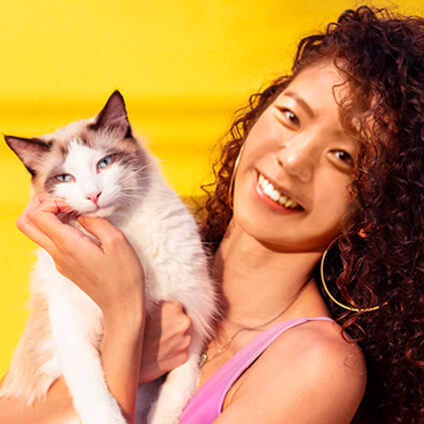
With over five years of specialized experience as an animal writer, my expertise lies in cat nutrition, health, behavior, grooming, and training. I am dedicated to delivering helpful and informative content that caters to the well-being of our feline friends. My primary goal is to empower pet owners with knowledge and ensure our feline companions thrive in health and happiness. In my free time, I love volunteering at local cat rescue centers.
